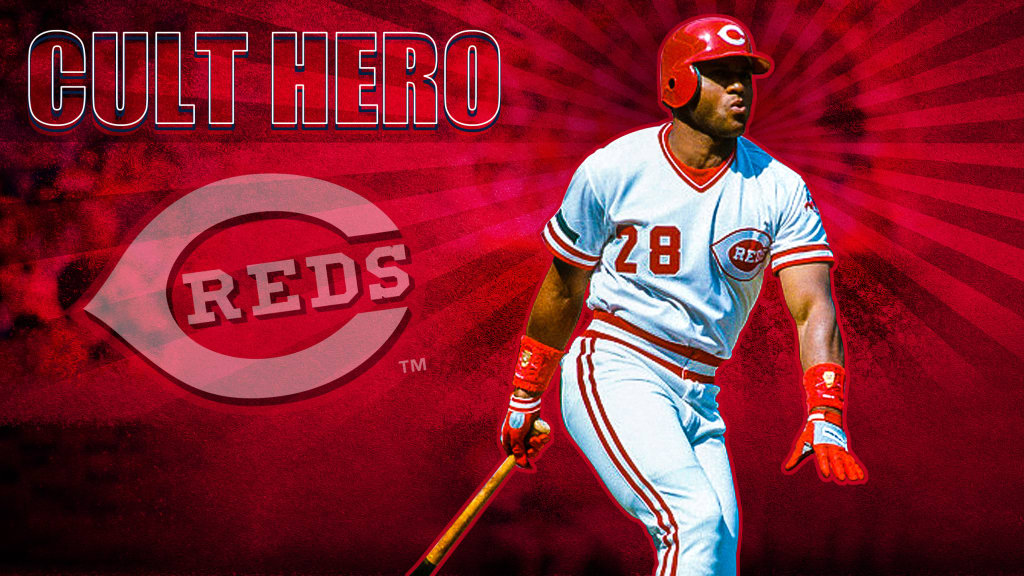
CINCINNATI -- Kal Daniels was 22 years old when he broke into the Major Leagues with the Reds in 1986, armed with a left-handed bat and a selective eye. What Daniels lacked was fear.
In 1989, Daniels was quoted as saying: “There’s no one I love to face, but I love to hit against anyone.”
As a rookie, Daniels became an instant sensation on a team that had budding stars like Barry Larkin, Eric Davis and Paul O’Neill. The left fielder batted .320/.398/.519 with six home runs in 74 games during the 1986 season.
“He didn’t let anyone down. He was one of the finest young hitters I’ve ever seen,” said former teammate Buddy Bell, now a Reds executive and the father of current manager David Bell. “Fans here hear about younger players, and then they come up and make a splash. Kal did that. He performed right away. The people loved seeing it and [watching] him produce. He was a popular player.”
The 1987 season was even better as Daniels batted .334 with a 1.046 OPS and 26 homers in 108 games, although then-manager Pete Rose used Daniels mostly in a platoon role with the right-handed Tracy Jones.
“He was very athletic and just a sweet-swinging hitter who never gave up an at-bat,” Bell said. “He had a good idea of the strike zone as a young player.”
Former Reds starting pitcher Tom Browning played at Rookie-level Billings with Daniels and knew there was something special there.
“As he moved his way up the ladder, he could always hit,” Browning said. “I’ve told people he’s the best hitter I ever saw. I liked him over Tony Gwynn and everybody else.”
Daniels could be cocky. He’d talk a good game in the clubhouse and later back it up on the field. That had even some veteran teammates gravitate toward him, including Bell.
“He had some confidence. He knew he could hit,” Bell said. “But it wasn’t in a bad way, by any means. It was more comical than anything else. Guys like [Dave] Parker, Ron Oester being around were really the leaders of the team. They had a good feel for our younger guys and could put him in his place if they needed to. With Kal, that would last about five minutes, and then he’d talk some more. It was all fun-loving.”
Daniels’ confidence showed, especially when he faced some of the best pitchers of the game. His career averages vs. Hall of Famers -- including Nolan Ryan (.353), Tom Glavine (.400), Greg Maddux (.471) and John Smoltz (.300) -- were exceptional.
Orel Hershiser, considered one of the elite pitchers in the 1980s, was also roughed up by the former Red, who batted .429 with four homers against him -- tied for the most homers off a single pitcher in Daniels’ career. Daniels also hit .368 off Rick Sutcliffe.
Against Hall of Fame closer Rich Gossage, two of Daniels’ three hits were home runs -- including the first of his Major League career on April 13, 1986, in San Diego. That long ball in the top of the ninth tied the game before the Padres walked it off a half-inning later.
“In order to be the best, you’ve got to face the best,” Daniels said during a 2017 interview on Jamie Ramsey’s Better Off Red podcast. “I just felt like anybody who steps on the mound, I was there to do a job, and I did my job the best I could.”
Daniels also had one of those quirky media moments during the regime of owner Marge Schott in 1989. After walking out of camp amid a contract dispute, Daniels wound up having his salary determined by the flip of a coin in the parking lot of the Reds’ Spring Training complex in Plant City, Fla. ESPN covered the flip live on television.
“It was very weird,” Daniels said. “To make a long story short, they flipped the coin, and I won.”
The Reds were believed to have offered no more than $300,000. Daniels wanted at least $325,000, and he ultimately earned that amount -- thanks to a coin.
Unfortunately for Daniels, he was frequently hampered by injuries to both of his knees, and that problem was exasperated by playing on an unforgiving artificial turf surface at Riverfront Stadium.
“Basically, I was going every other year: right knee, left knee, right knee,” Daniels said. “I’ve had four [surgeries] on my right knee and two on my left. I don’t dwell on that. I just thank the Lord that he gave me the ability to get to the Major Leagues, and I thank him even more for the time he let me last to stay there.”
Daniels’ production had plummeted by 1989, when he batted .218 with a .346 slugging percentage in 44 games before the Reds traded him and utility player Lenny Harris to the Dodgers in July for second baseman Mariano Duncan and pitcher Tim Leary.
Following the 1992 season with the Cubs, Daniels saw his baseball career end at only 28 years old.
“If he had been like Andre Dawson and played on grass a little earlier, he could have probably had a bigger and better career,” Browning said. “I know his knees took a pounding.”
